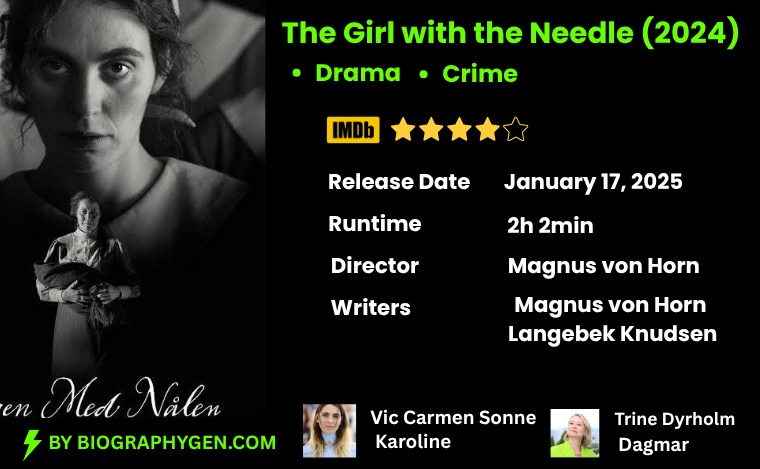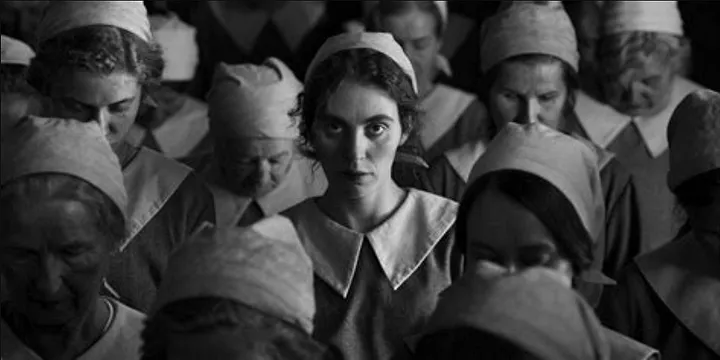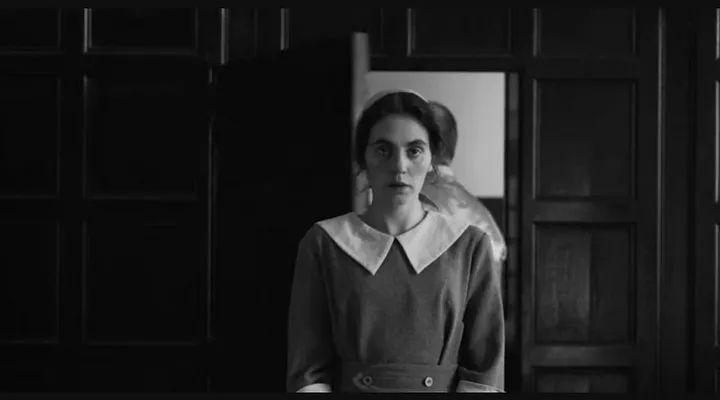The Girl with the Needle 2024
The Girl with the Needle is a Gothic historical psychological horror film from 2024, helmed by director Magnus von

The Girl with the Needle is a Gothic historical psychological horror film from 2024, helmed by director Magnus von Horn, who co-wrote the script with Line Langebek. Taking place in 1919, the narrative follows Vic Carmen Sonne as a young woman who starts her job as a wet nurse at a secretive adoption agency catering to less fortunate mothers, but she soon grows wary of the agency’s operator. The film draws very loose inspiration from the real-life story of Danish serial killer Dagmar Overbye.
This film was chosen to vie for the Palme d’Or at the 77th Cannes Film Festival and made its debut on May 15, 2024, receiving rave reviews. The National Board of Review recognized it as one of the top five international films of 2024. It secured a nomination for Best Foreign Language Film at the 82nd Golden Globe Awards and was also nominated for Best International Feature Film at the 97th Academy Awards.

The Girl with the Needle

The phrase “based on a true story” carries significant weight for audiences. When it appears at the beginning, viewers tend to engage with the film more earnestly, contemplating the lives of those unfortunate individuals their stories represent. However, when this statement is featured at the conclusion, the impact can be even more profound. In “The Girl with the Needle,” a film made in collaboration between Denmark, Poland, and Sweden, the underlying message, if any exists, is stark: women face insurmountable barriers in the world.
One day, while bathing, Karoline’s (Vic Carmen Sonne) life unravels. Her landlord informs her she must leave her apartment. New tenants are scheduled to view the place; they are a mother and her child. The mother’s demeanor is far from nurturing: when the girl expresses her reluctance to live there due to rats, the mother slaps her. How does Karoline envision herself as a mother? We won’t have to wait long to discover the answer.
Karoline toils as a seamstress in a factory, while her husband Peter (Besir Zeciri) is off fighting in World War I and has gone missing. When she seeks a pension for widows, she suddenly finds herself growing close to the factory director, Jørgen (Joachim Fjelstrup). Peter eventually returns from the war with severe facial injuries, and Karoline decides to send him away, as she is expecting a child and plans to marry Jørgen. However, his mother, the Baroness, opposes the union.
Without a spouse or employment, a physician employed by the Baroness informs Karoline that it is too late for her to terminate the pregnancy. Is this correct? The reality is that one can always access abortion services at any time. She proceeds to insert a needle into her vagina while in a communal bath, as her new residence lacks a private restroom. A woman called Dagmar (Trine Dyrholm), appearing compassionate, intervenes before Karoline can complete the procedure and persuades her to consider placing the child for adoption — though this option will come at a cost, quite literally.

The individual next in line for rescue is Peter, who performed as a sideshow act in a circus. For soldiers returning from the war disfigured, this was one of the available options, and there were countless such cases following World War I. At that time, plastic surgery was not advanced, and often, the only means for them to step outside without drawing too much attention were prosthetics and masks. A film that addresses this situation is the French production “See You Up There / Au Revoir là-haut” (2017), which is definitely worth watching if you haven’t seen it yet.
There is a moment depicted where the factory workers are exiting, which pays homage to the groundbreaking cinematography of the Lumière brothers, created roughly 20 years prior to the film’s setting. Some of the most impactful scenes occur without dialogue, such as Karoline’s unusual flirtation with the factory manager. During a moment of silence observed at the factory to honor those lost in the war, Karoline and the director exchange warm glances. However, it is quite peculiar that when Karoline and Dagmar attend a film, someone is singing in Portuguese over the screening!
The leading actress reminded me of a different Danish star: Asta Nielsen (1881–1972). In 1910, Nielsen became one of cinema’s first international sensations alongside French comedian Max Linder after performing a seductive dance in “The Abyss.” Two years later, she and her spouse, director Urban Gad, moved to Germany, where they collaborated on thirty films over six years before divorcing in 1918. Similar to Vic Carmen Sonne in “The Girl with the Needle,” Asta Nielsen’s expressive gaze was her most distinguished attribute.

Many individuals still incorrectly or insincerely liken abortion to murder. Terminating a group of cells or a nonviable fetus is not equivalent to taking the life of a fully developed, independent human. Suggesting that a pregnant individual endure nine months of pregnancy and childbirth just to relinquish a child for adoption is absurd; a person should not be reduced to an incubator; and, as depicted in the film, this does not guarantee that the child will be welcomed into a loving family.
A lot has been discussed regarding the various shocks within the film, especially the most apparent one. It serves as a metaphor: Karoline’s personal experiences reflect and comment on Europe’s journey emerging from the largest conflict in history up to that moment. Both Karoline and Europe bear lasting scars from their experiences, and we, in turn, are affected by what we have just witnessed.






2 Comments
jlkuyg
v6nnhd